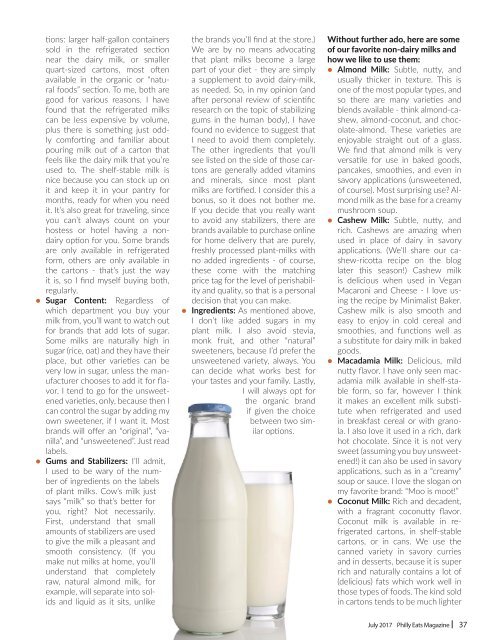Philly Eats Magazine Second Edition 2017
The July Edition of Philly Eats includes a feature on the home of the Phillies Citizens Bank Park.
The July Edition of Philly Eats includes a feature on the home of the Phillies Citizens Bank Park.
You also want an ePaper? Increase the reach of your titles
YUMPU automatically turns print PDFs into web optimized ePapers that Google loves.
tions: larger half-gallon containers<br />
sold in the refrigerated section<br />
near the dairy milk, or smaller<br />
quart-sized cartons, most often<br />
available in the organic or “natural<br />
foods” section. To me, both are<br />
good for various reasons. I have<br />
found that the refrigerated milks<br />
can be less expensive by volume,<br />
plus there is something just oddly<br />
comforting and familiar about<br />
pouring milk out of a carton that<br />
feels like the dairy milk that you’re<br />
used to. The shelf-stable milk is<br />
nice because you can stock up on<br />
it and keep it in your pantry for<br />
months, ready for when you need<br />
it. It’s also great for traveling, since<br />
you can’t always count on your<br />
hostess or hotel having a nondairy<br />
option for you. Some brands<br />
are only available in refrigerated<br />
form, others are only available in<br />
the cartons - that’s just the way<br />
it is, so I find myself buying both,<br />
regularly.<br />
● Sugar Content: Regardless of<br />
which department you buy your<br />
milk from, you’ll want to watch out<br />
for brands that add lots of sugar.<br />
Some milks are naturally high in<br />
sugar (rice, oat) and they have their<br />
place, but other varieties can be<br />
very low in sugar, unless the manufacturer<br />
chooses to add it for flavor.<br />
I tend to go for the unsweetened<br />
varieties, only, because then I<br />
can control the sugar by adding my<br />
own sweetener, if I want it. Most<br />
brands will offer an “original”, “vanilla”,<br />
and “unsweetened”. Just read<br />
labels.<br />
● Gums and Stabilizers: I’ll admit,<br />
I used to be wary of the number<br />
of ingredients on the labels<br />
of plant milks. Cow’s milk just<br />
says “milk” so that’s better for<br />
you, right? Not necessarily.<br />
First, understand that small<br />
amounts of stabilizers are used<br />
to give the milk a pleasant and<br />
smooth consistency. (If you<br />
make nut milks at home, you’ll<br />
understand that completely<br />
raw, natural almond milk, for<br />
example, will separate into solids<br />
and liquid as it sits, unlike<br />
the brands you’ll find at the store.)<br />
We are by no means advocating<br />
that plant milks become a large<br />
part of your diet - they are simply<br />
a supplement to avoid dairy-milk,<br />
as needed. So, in my opinion (and<br />
after personal review of scientific<br />
research on the topic of stabilizing<br />
gums in the human body), I have<br />
found no evidence to suggest that<br />
I need to avoid them completely.<br />
The other ingredients that you’ll<br />
see listed on the side of those cartons<br />
are generally added vitamins<br />
and minerals, since most plant<br />
milks are fortified. I consider this a<br />
bonus, so it does not bother me.<br />
If you decide that you really want<br />
to avoid any stabilizers, there are<br />
brands available to purchase online<br />
for home delivery that are purely,<br />
freshly processed plant-milks with<br />
no added ingredients - of course,<br />
these come with the matching<br />
price tag for the level of perishability<br />
and quality, so that is a personal<br />
decision that you can make.<br />
● Ingredients: As mentioned above,<br />
I don’t like added sugars in my<br />
plant milk. I also avoid stevia,<br />
monk fruit, and other “natural”<br />
sweeteners, because I’d prefer the<br />
unsweetened variety, always. You<br />
can decide what works best for<br />
your tastes and your family. Lastly,<br />
I will always opt for<br />
the organic brand<br />
if given the choice<br />
between two similar<br />
options.<br />
Without further ado, here are some<br />
of our favorite non-dairy milks and<br />
how we like to use them:<br />
● Almond Milk: Subtle, nutty, and<br />
usually thicker in texture. This is<br />
one of the most popular types, and<br />
so there are many varieties and<br />
blends available - think almond-cashew,<br />
almond-coconut, and chocolate-almond.<br />
These varieties are<br />
enjoyable straight out of a glass.<br />
We find that almond milk is very<br />
versatile for use in baked goods,<br />
pancakes, smoothies, and even in<br />
savory applications (unsweetened,<br />
of course). Most surprising use? Almond<br />
milk as the base for a creamy<br />
mushroom soup.<br />
● Cashew Milk: Subtle, nutty, and<br />
rich. Cashews are amazing when<br />
used in place of dairy in savory<br />
applications. (We’ll share our cashew-ricotta<br />
recipe on the blog<br />
later this season!) Cashew milk<br />
is delicious when used in Vegan<br />
Macaroni and Cheese - I love using<br />
the recipe by Minimalist Baker.<br />
Cashew milk is also smooth and<br />
easy to enjoy in cold cereal and<br />
smoothies, and functions well as<br />
a substitute for dairy milk in baked<br />
goods.<br />
● Macadamia Milk: Delicious, mild<br />
nutty flavor. I have only seen macadamia<br />
milk available in shelf-stable<br />
form, so far, however I think<br />
it makes an excellent milk substitute<br />
when refrigerated and used<br />
in breakfast cereal or with granola.<br />
I also love it used in a rich, dark<br />
hot chocolate. Since it is not very<br />
sweet (assuming you buy unsweetened!)<br />
it can also be used in savory<br />
applications, such as in a “creamy”<br />
soup or sauce. I love the slogan on<br />
my favorite brand: “Moo is moot!”<br />
● Coconut Milk: Rich and decadent,<br />
with a fragrant coconutty flavor.<br />
Coconut milk is available in refrigerated<br />
cartons, in shelf-stable<br />
cartons, or in cans. We use the<br />
canned variety in savory curries<br />
and in desserts, because it is super<br />
rich and naturally contains a lot of<br />
(delicious) fats which work well in<br />
those types of foods. The kind sold<br />
in cartons tends to be much lighter<br />
July <strong>2017</strong> <strong>Philly</strong> <strong>Eats</strong> <strong>Magazine</strong> 37












